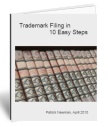 Basis for Filing
Basis for Filing
The application should include your “basis” for filing. Most U.S. applicants base their application on their current use of the mark in commerce, or their intent to use their mark in commerce in the future.
Use in Commerce
For the purpose of obtaining federal registration, “commerce” means all commerce that the U.S. Congress may lawfully regulate; for example, interstate commerce or commerce between the U.S. and another country. “Use in commerce” must be a bona fide use of the mark in the ordinary course of trade, and not use simply made to reserve rights in the mark. Generally, acceptable use is as follows:
- For goods: the mark must appear on the goods, the container for the goods, or displays associated with the goods, and the goods must be sold or transported in commerce.
- For services: the mark must be used or displayed in the sale or advertising of the services and the services must be rendered in commerce.
If you have already started using the mark in commerce, you may file based on that use. A “use” based application must include a sworn statement (usually in the form of a declaration) that the mark is in use in commerce, listing the date of first use of the mark anywhere and the date of first use of the mark in commerce. A properly worded declaration is included in the USPTO standard application form. The applicant or a person authorized to sign on behalf of the applicant must sign the statement. The application should include a specimen showing use of the mark in commerce.
Intent to Use
If you have not yet used the mark, but plan to do so in the future, you may file based on a good faith or bona fide intention to use the mark in commerce. You do not have to use the mark before you file your application.
An “intent to use” application must include a sworn statement (usually in the form of a declaration) that you have a bona fide intention to use the mark in commerce. A properly worded declaration is included in the USPTO standard application form. The applicant or a person authorized to sign on behalf of the applicant must sign the statement.
NOTE: If you file based on intent to use, you must begin actual use of the mark in commerce before the USPTO will register the mark; that is, after filing an application based on “intent to use,” you must later file another form (“Allegation of Use”) to establish that use has begun. See “Additional Requirements for ‘Intent to Use’ Applications” for more information.
International Agreements
Although not as common, you may base your application on international agreements. Under certain international agreements, if you qualify, you may file in the U.S. based on a foreign application or on a registration in your country of origin.
Also, section 66(a) of the Trademark Act permits the holder of an international registration to file a request for extension of protection of the international registration to the United States under the Madrid Protocol.
Continue reading Trademark Filing Basics – Part 4: Basis for Filing and Specimens






